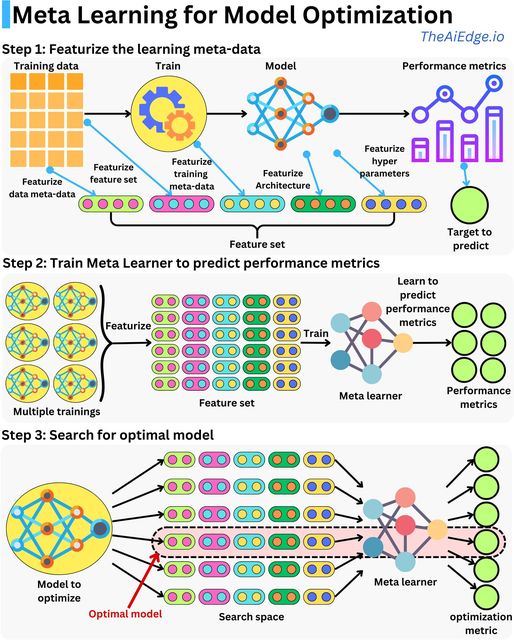Meta learning for model optimization
Meta learning, often described as "learning to learn," is a powerful approach in the field of machine learning aimed at improving the efficiency and effectiveness of model training. By leveraging previous learning experiences, meta learning helps in identifying optimal models and hyperparameters more efficiently. The following guide, inspired by the provided infographic, outlines the three critical steps involved in meta learning for model optimization.

Step 1: Featurize the Learning Meta-Data
1.1 Gather Training Data
The process begins with collecting the initial training data. This data serves as the foundation for building and optimizing machine learning models.
1.2 Featurize Data Meta-Data
Next, the data meta-data is featurized. This step involves extracting and organizing relevant features from the raw training data to create a structured feature set that can be used for further analysis and model training.
1.3 Train Initial Model
Using the featurized data, an initial model is trained. This model will serve as the baseline for further optimization.
1.4 Featurize Training Meta-Data
After training the initial model, the training meta-data, including aspects such as model architecture, hyperparameters, and performance metrics, is featurized. These features provide critical insights into how different model configurations perform.
1.5 Create Feature Set
Combining the data meta-data, training meta-data, and performance metrics results in a comprehensive feature set. This feature set is crucial for predicting the performance of various model configurations.
Step 2: Train Meta Learner to Predict Performance Metrics
2.1 Conduct Multiple Trainings
To build a robust meta learner, multiple training sessions are conducted. Each session explores different model architectures, hyperparameters, and training conditions.
2.2 Featurize Training Data
The data from these multiple trainings is then featurized, similar to the process in Step 1. This includes extracting features from the training data, model architectures, and performance metrics.
2.3 Train Meta Learner
The featurized data from the multiple training sessions is used to train a meta learner. The meta learner is designed to predict performance metrics based on the provided feature set.
2.4 Predict Performance Metrics
Once trained, the meta learner can predict the performance metrics of new model configurations. This prediction capability allows for the efficient evaluation of potential models without the need for extensive training sessions.
Step 3: Search for Optimal Model
3.1 Define Search Space
With the meta learner in place, the next step is to define the search space. This space includes various potential model configurations and hyperparameters that need to be explored.
3.2 Evaluate Models with Meta Learner
The meta learner is used to evaluate the performance of models within the search space. By predicting the performance metrics, the meta learner helps identify promising models without exhaustive training.
3.3 Identify Optimal Model
The evaluation process continues until the optimal model is identified. This model is the one predicted to have the best performance metrics based on the meta learner's evaluations.
3.4 Optimize Model
The final step involves optimizing the identified model. This optimization ensures that the model performs at its best when applied to real-world data.
Conclusion
Meta learning for model optimization is a sophisticated process that leverages previous learning experiences to enhance the efficiency and effectiveness of machine learning models. By systematically featurizing data, training meta learners, and searching for optimal models, meta learning can significantly reduce the time and computational resources required for model development. This approach not only improves model performance but also accelerates the innovation cycle in the field of machine learning.